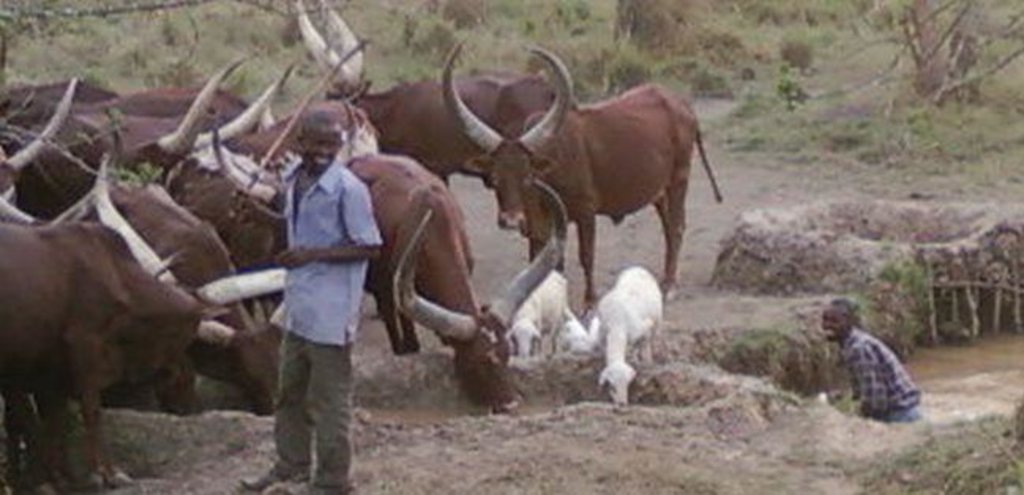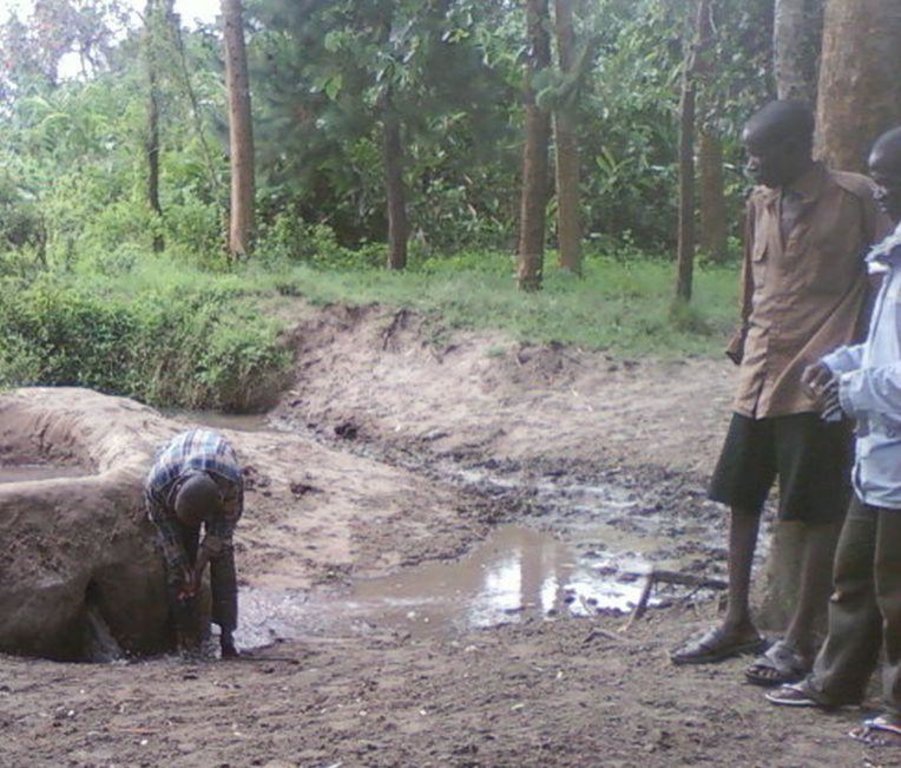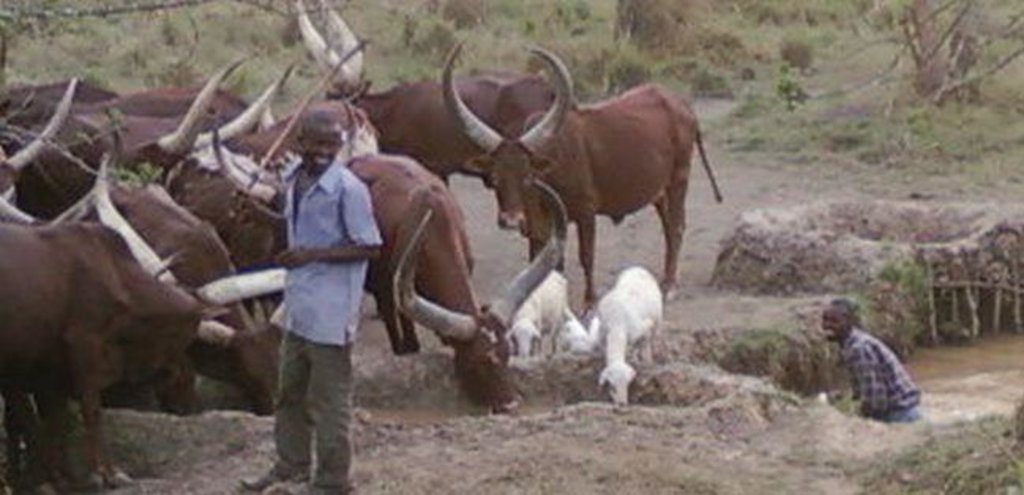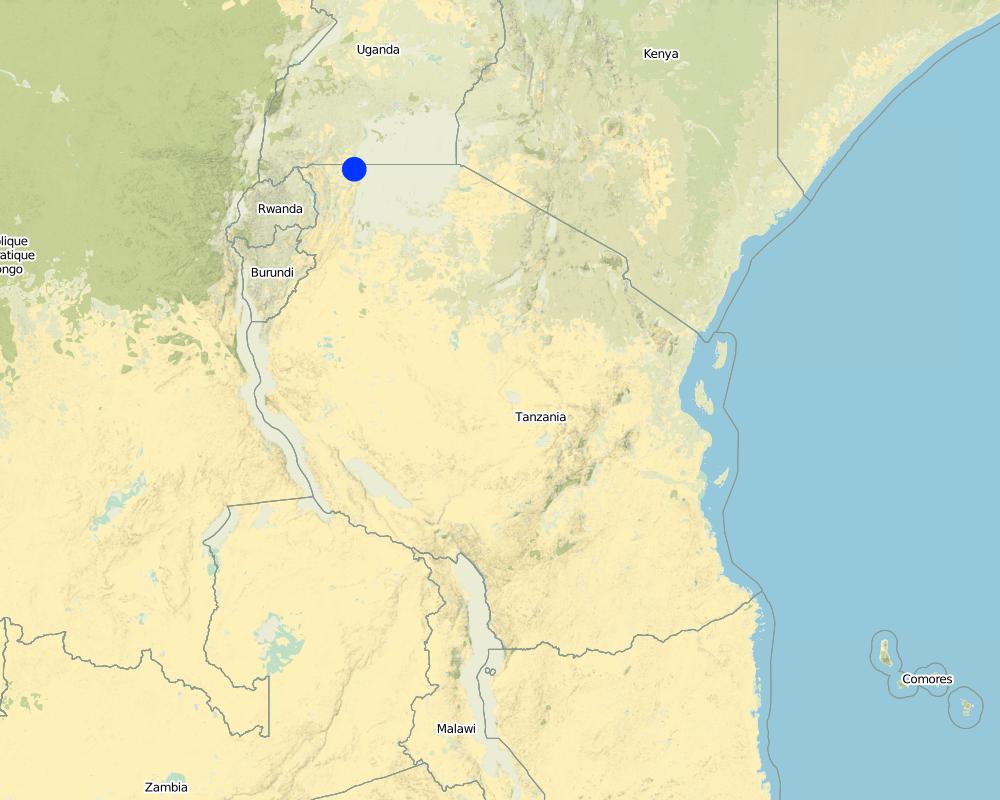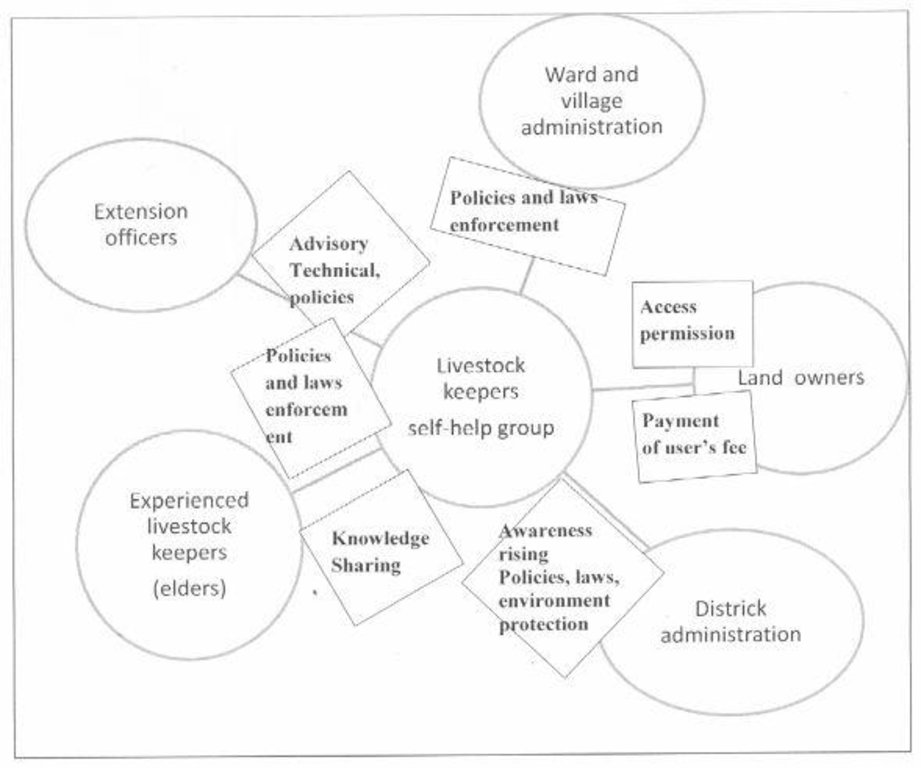Livestock keepers initiative for continued dry season animal drinking water supply [แทนซาเนีย]
- ผู้สร้างสรรค์:
- การอัพเดท:
- ผู้รวบรวม: ALLAN BUBELWA
- ผู้เรียบเรียง: –
- ผู้ตรวจสอบ: Fabian Ottiger
Emigilile ya abatungi b’ente oyokueshela ente
approaches_2589 - แทนซาเนีย
ดูส่วนย่อย
ขยายทั้งหมด ย่อทั้งหมด1. ข้อมูลทั่วไป
1.2 รายละเอียดที่ติดต่อได้ของผู้รวบรวมและองค์กรที่เกี่ยวข้องในการประเมินและการจัดเตรียมทำเอกสารของแนวทาง
ผู้เชี่ยวชาญ SLM:
ผู้เชี่ยวชาญ SLM:
ผู้เชี่ยวชาญ SLM:
Subira John
Missenyi district council
แทนซาเนีย
ผู้เชี่ยวชาญ SLM:
Kagaruki Annagrace
Missenyi district council
แทนซาเนีย
ผู้เชี่ยวชาญ SLM:
Kitundu Elizabeth
+255 0732983531,
missenyicouncil@yahoo.com
Missenyi District Council
Box 38 Kyaka Missenyi Kagera
แทนซาเนีย
ผู้เชี่ยวชาญ SLM:
Kaihura Fidelis
National Project Manager
แทนซาเนีย
ชื่อของโครงการซึ่งอำนวยความสะดวกในการทำเอกสารหรือการประเมินแนวทาง (ถ้าเกี่ยวข้อง)
The Transboundary Agro-ecosystem Management Project for the Kagera River Basin (GEF-FAO / Kagera TAMP )ชื่อของโครงการซึ่งอำนวยความสะดวกในการทำเอกสารหรือการประเมินแนวทาง (ถ้าเกี่ยวข้อง)
Food and Agriculture Organization of the United Nations (FAO) - อิตาลีชื่อของโครงการซึ่งอำนวยความสะดวกในการทำเอกสารหรือการประเมินแนวทาง (ถ้าเกี่ยวข้อง)
Missenyi District Council (Missenyi District Council) - แทนซาเนีย1.3 เงื่อนไขที่เกี่ยวข้องกับการใช้ข้อมูลที่ได้บันทึกไว้ผ่านทาง WOCAT
วันที่เก็บรวบรวมข้อมูล (ภาคสนาม):
28/08/2012
ผู้รวบรวมและวิทยากรหลักยอมรับเงื่อนไขเกี่ยวกับการใช้ข้อมูลที่ถูกบันทึกผ่านทาง WOCAT:
ใช่
1.4 การอ้างอิงถึงแบบสอบถามเรื่องเทคโนโลยี SLM
2. คำอธิบายของแนวทาง SLM
2.1 การอธิบายแบบสั้น ๆ ของแนวทาง
Livestock keepers groups and local government collaboration for management of livestock watering points.
2.2 การอธิบายอย่างละเอียดของแนวทาง
การอธิบายอย่างละเอียดของแนวทาง:
Aims / objectives: The main aim of this approach is to improve management of water resources through strengthening collaboration between land owners and livestock keepers for efficient livestock production/management and increased incomes. This approach ensures livestock watering point accessibility during dry seasons. Objective is to reach a compromise between livestock keepers and land owners on terms of conditions for access and use of watering points. As results livestock keepers and land owner can improve their planning activities and minimize conflict between them.
Methods: A self-help livestock keepers group is normally formed. It establishes regular and efficient cooperation among the livestock keepers and negotiations with land owners on water access issues. They make financial contributions to support the established self-help group. Through these contributions construction and maintenance of the ponds and troughs (the livestock watering system) is assured. Construction and maintenance is also done through voluntary work.
This traditional system was developed by elders and spread through learning by doing from the old to the young generation. In passing over knowledge from the elderly to the youths, experience in livestock and water resources management systems is gained.
The approach is also characterized by reverence to the existing village by-laws reinforced by the village government as well as existing customary laws to prevent degradation and pollution of water sources. Extension officers provide technical backstopping on recommended animal health practices that include deworming, routine spraying and vaccination against diseases.
Stages of implementation: Implementation takes place in three stages
1) Livestock keeper group formation: The group size is determined by the number of livestock. A single trough can accommodate not more than 150 cattle which determine the number of livestock keepers to form a group. The group has its informal organizational system with a nominated leader.
2) Contributions and voluntary works: Each livestock keeper makes a payment of about 20 dollars to the land owner as annual user fee. Maintenance is the responsibility of all livestock keepers.
3) Management: Include use of by-laws and provision of advisory services
Role of stakeholders: Land owner: He has the key role of ensuring that the area is used in a sustainable manner. Group members pay land rent to him for area utilization and management.
Livestock keepers: These are key users of the area, voluntarily participate in construction and maintenance of water troughs, pay land rent, manage and control watering of their animals.
Village and Ward administration and elders: Ensuring that village by-laws and customary laws guiding use of fragile ecosystems are adhered to.
Ward and village extension officers: Provide technical advisory to livestock keepers.
District administration and extension staff: Facilitating and enabling community understanding of policy, acts and laws guiding use of fragile ecosystems so that they can make informed management decision.
Other important information: This approach plays significant role in preventing conflict between domestic water users and livestock keepers especially during the dry season.
2.3 รูปภาพของแนวทาง
2.5 ประเทศ ภูมิภาค หรือสถานที่ตั้งที่ได้นำแนวทางไปใช้
ประเทศ:
แทนซาเนีย
ภูมิภาค/รัฐ/จังหวัด: :
TANZANIA
ข้อมูลเฉพาะเพิ่มเติมของสถานที่ตั้ง:
MISSENYI
Map
×2.7 ประเภทของแนวทาง
- แบบดั้งเดิม/ แบบพื้นเมิอง
2.8 เป้าหมายหรือวัตถุประสงค์หลักของแนวทาง
The Approach focused mainly on SLM with other activities (Construction, managment and utilization)
Minimizing of land dagradation and better water availability to contribute to livelihood improvement.
The SLM Approach addressed the following problems: 1. There was no livestock keepers organization to comprise over use of water resource during the dry season.
2. Water use conflict between livestock keepers and domestic water users
3. Weak administration of bylaws.
2.9 เงื่อนไขที่เอื้ออำนวยหรือเป็นอุปสรรคต่อการนำเทคโนโลยีภายใต้แนวทางนี้ไปปฏิบัติใช้
บรรทัดฐานและค่านิยมทางสังคม วัฒนธรรม ศาสนา
- เป็นอุปสรรค
Traditionally livestock keepers keep large herds for prestige.
Treatment through the SLM Approach: Livestock keeper with large herds are advised to reduce number of animals by selling extra animals and use funds for intensifying management and maximizing productivity.
การมีไว้ให้หรือการเข้าถึงแหล่งการเงินและบริการ
- เป็นอุปสรรค
Livestock keepers are not aware of the services provided by financial institutions and are ignorant of the basic bookkeeping skills.
Treatment through the SLM Approach: Sensitized livestock keepers on utilization of financial institutions and provide training in the basic bookkeeping skills.
การจัดตั้งระดับองค์กร
- เป็นอุปสรรค
Livestock keepers informally organized but not legally recognized; the groups are not registered and have no written constitution.
Treatment through the SLM Approach: Livestock keeper advised to strengthen their groups/organization through registration by relevant authorities and establish a written group constitution.
กรอบแนวทางในการดำเนินการด้านกฎหมาย (การถือครองที่ดิน สิทธิในการใช้ที่ดินและน้ำ)
- เป็นอุปสรรค
Ignorance of livestock keepers on the Act, Laws and Rules governing the use of fragile ecosystems.
Treatment through the SLM Approach: Extension workers enabling and facilitating community understanding of policy and acts guiding use of fragile ecosystems.
ความรู้เกี่ยวกับ SLM การเข้าถึงการสนับสนุนด้านเทคนิค
- เป็นอุปสรรค
Low knowledge on recommended livestock rearing practises and water borne diseases.
Treatment through the SLM Approach: Training livestock keepers on recommended livestock rearing practices, prevention and controll of water borne diseases as well as water hygine and sanitation.
ปริมาณงานที่ทำได้ กำลังคนที่มีให้
- เป็นอุปสรรค
High work load needed in filling of the water troughs
Treatment through the SLM Approach: Livestock keepers advised to use water pumping machines (simple and manually operated machines).
3. การมีส่วนร่วมและบทบาทของผู้มีส่วนได้ส่วนเสียที่เกี่ยวข้อง
3.1 ผู้มีส่วนได้ส่วนเสียที่เกี่ยวข้องในแนวทางนี้และบทบาท
- ผู้ใช้ที่ดินระดับท้องถิ่นหรือชุมชนระดับท้องถิ่น
Key implementer and user of the SLM approach, the land owner and the livestock keepers
Traditionally grazing stocks (cattle, sheep and goats) are owned and reared by men and therefore the approach mainly involves men. The roles area largely men specific.The approach also targeted low income livestock owners (casual cattle herds man).
- ผู้เชี่ยวชาญ SLM หรือที่ปรึกษาการเกษตร
District, ward and village extension officers
- รัฐบาลระดับท้องถิ่น
Provision of technical advisory services, policy and act interpretation and reinforcement of village bylaws.
- รัฐบาลแห่งชาติ (ผู้วางแผน ผู้ทำการตัดสินใจ)
Village and Ward elected and employed representatives.
3.2 การเกี่ยวข้องของผู้ใช้ที่ดินระดับท้องถิ่นหรือชุมชนระดับท้องถิ่นในช่วงต่างๆของแนวทาง
| ความเกี่ยวข้องของผู้ใช้ที่ดินระดับท้องถิ่นหรือชุมชนระดับท้องถิ่น | ระบุผู้ที่มีส่วนเกี่ยวข้องและอธิบายกิจกรรม | |
|---|---|---|
| การริเริ่มหรือการจูงใจ | ระดมกำลังด้วยตนเอง | Livestock keepers /elders: Inheritance and transference of the approach to youth. |
| การวางแผน | ระดมกำลังด้วยตนเอง | Livestock keepers /elders: Informal planning and improvement through cycles of action and reflection. |
| การดำเนินการ | ระดมกำลังด้วยตนเอง | Livestock keepers individuals and groups, village leaders and agricultural advisers: use of the approach, law enforcement and technical advisory services and interpretation of act, law and guidelines protecting fragile ecosystems. |
| การติดตามตรวจสอบหรือการประเมินผล | ระดมกำลังด้วยตนเอง | Livestock keepers individuals and groups, village leaders and agricultural advisers and SLM specialists: manage effective use of the technology, ensure adherence of Acts, Rules and Regulation and SLM documentation for dissemination and sharing. |
| Research | ปฏิสัมพันธ์ | Livestock keepers individuals and groups and agricultural advisers and SLM specialists: identification and documentation of researchable issues. |
3.3 แผนผังแสดงขั้นตอนการทำงาน (ถ้ามี)
คำอธิบาย:
Livestock keepers initiative for continued dry season animal drinking water supply.
ผู้เขียน:
Allan Bubelwa (Box 38 Kyaka, Missenyi, Kagera, United Tanzania)
3.4 การตัดสินใจเลือกใช้เทคโนโลยี SLM
ระบุผู้ที่ทำการตัดสินใจเลือกเทคโนโลยีมากกว่าหนึ่งวิธีไปปฏิบัติใช้:
- ผู้ใช้ที่ดินเพียงผู้เดียว ( ริเริ่มด้วยตัวเอง)
การอธิบาย:
A decision to use the technology relies on livestock keepers self-mobilization, own choice induced through inheritance and learning by doing.
Decisions on the method of implementing the SLM Technology were made by by land users* alone (self-initiative / bottom-up). Decision to use the method is partly through spontaneous adoption from elders and improvement through cycles of action and reflection.
4. การสนับสนุนด้านเทคนิค การสร้างขีดความสามารถ และการจัดการด้านความรู้
4.1 การสร้างขีดความสามารถ / การอบรม
ได้มีการจัดอบรมให้แก่ผู้ใช้ที่ดินหรือผู้มีส่วนได้ส่วนเสียคนอื่น ๆ หรือไม่:
ใช่
ให้ระบุว่าใครเป็นผู้ได้รับการอบรม:
- ผู้ใช้ที่ดิน
- เจ้าหน้าที่ภาคสนาม / ที่ปรึกษา
- village and ward leaders
ถ้าเกี่ยวข้อง ให้ระบุ เพศ อายุ สถานภาพ ชาติพันธุ์ เป็นต้น:
both men and women and all ages (youth and elders).
รูปแบบการอบรม:
- กำลังดำเนินการ
- จัดการประชุมสู่สาธารณชน
รูปแบบการอบรม:
- seminar and workshops.
หัวข้อที่พูด:
Act and Laws guiding the use of fragile ecosystems, prevention of water borne diseases, recommended livestock keeping methods and water management.
4.2 การบริการให้คำแนะนำ
ผู้ใช้ที่ดินมีการเข้าถึงการรับบริการให้คำปรึกษาหรือไม่:
ใช่
ระบุว่ามีบริการให้คำปรึกษาหรือไม่:
- ไปเยี่ยมชมสถานที่
การอธิบาย/แสดงความคิดเห็น:
Name of method used for advisory service: Farmer field school ; Key elements: learning by doing on the job and in the field (Number of knowledge sharing activities: on the job training, field practice), adult learning – livestock self-help groups , livestock management. , indegenous and technical knowledge balanced and combined in a complementary manner.; Technical advisory services largely involved building on and improving the successful experience resulted from the use of indigenous knowledge.
Advisory service is quite adequate to ensure the continuation of land conservation activities; The increase number of extension workers from 1 to 2 and introduction of TAMP project (trans boundary agro-ecosystem management project) in the village will speed up implementation of conservation activities in the village.
4.3 การเสริมความแข็งแกร่งให้กับสถาบัน (การพัฒนาองค์กร)
สถาบันได้รับการจัดตั้งขึ้นมาหรือเสริมความแข็งแกร่งโดยแนวทางนี้หรือไม่:
- ไม่
4.4 การติดตามตรวจสอบและประเมินผล
การติดตามตรวจสอบและประเมินผลเป็นส่วนหนึ่งของแนวทางหรือไม่:
ใช่
ความคิดเห็น:
bio-physical aspects were ad hoc monitored by government, land users through observations; indicators: extent of area eroded
bio-physical aspects were ad hoc monitored by government, land users through measurements; indicators: Ponds/troughs and maintenance requirements
technical aspects were ad hoc monitored by land users through observations; indicators: number of livestock keeper trained
technical aspects were ad hoc monitored by land users through measurements; indicators: number of conflicts between land owners and livestock keepers
socio-cultural aspects were ad hoc monitored by land users through observations; indicators: number of water conflict emerged and number resolved
socio-cultural aspects were ad hoc monitored by government, land users through measurements; indicators: livestock production and productivity
economic / production aspects were regular monitored by government through observations; indicators: increase in milk and meat productivity
economic / production aspects were regular monitored by government, land users through measurements; indicators: livestock keepers using the technology
no. of land users involved aspects were regular monitored by government, land users through observations; indicators: number of livestock keepers using the technology
no. of land users involved aspects were regular monitored by government, land users through measurements; indicators: adherence to water protective bylaws
management of Approach aspects were regular monitored by government through observations; indicators: % number of village bylaws used and adhered to
management of Approach aspects were regular monitored by government through measurements; indicators: None
There were few changes in the Approach as a result of monitoring and evaluation: Implementation of group roles and adherence to by-laws e.g. protection of natural vegetation.
There were few changes in the Technology as a result of monitoring and evaluation: decrease in destruction of natural vegetation and reduction of eutrophication at the water source.
4.5 การวิจัย
การวิจัยเป็นส่วนหนึ่งของแนวทางหรือไม่:
ใช่
- adaptive SLM trials
ให้ข้อมูลเพิ่มเติมและให้ระบุผู้ทำการวิจัย:
Adaptive trials through SLM demos by TAMP, ARI MARUKU and community. Farmers select the best bets technologies to apply on their own fields.
Research was carried out on-farm
5. การสนับสนุนด้านการเงินและวัสดุอุปกรณ์
5.1 ระบุงบประมาณประจำปีสำหรับแนวทาง SLM นี้
ถ้าหากว่างบประมาณประจำปีไม่เป็นที่ทราบแน่นอน ให้ระบุช่วงลงไป:
- < 2,000
แสดงความคิดเห็น (แหล่งของการระดมทุน ผู้บริจาคคนสำคัญ):
Approach costs were met by the following donors: local government (district, county, municipality, village etc) (animal related extesion services, policy and law enforcement.): 20.0%; local community / land user(s) (voluntary contribution by livestock keeper groups and land owner ): 80.0%
5.2 การสนับสนุนด้านการเงิน / วัสดุอุปกรณ์ให้แก่ผู้ใช้ที่ดิน
ผู้ใช้ที่ดินได้รับการสนับสนุนด้านการเงิน / วัสดุอุปกรณ์ไปปฏิบัติใช้เทคโนโลยีหรือไม่:
ไม่ใช่
5.3 เงินสนับสนุนสำหรับปัจจัยนำเข้า (รวมถึงแรงงาน)
ถ้าแรงงานโดยผู้ใช้ที่ดินเป็นปัจจัยนำเข้าที่มีอยู่มากมาย ระบุด้วยว่าเนื่องจาก:
- สมัครใจ
ความคิดเห็น:
labour is needed in taking the animals for watering as well as during actual watering of the animals.
5.4 เครดิต
มีการจัดหาเครดิตมาให้ภายใต้แนวทาง SLM หรือไม่:
ไม่ใช่
6. การวิเคราะห์ผลกระทบและการสรุป
6.1 ผลกระทบของแนวทาง
ช่วยให้ผู้ใช้ที่ดินนำเอาเทคโนโลยี SLMไปใช้และบำรุงรักษาสภาพไว้ได้หรือไม่:
- ไม่ใช่
- ใช่ เล็กน้อย
- ใช่ ปานกลาง
- ใช่ อย่างมาก
This approach plays significant role in reducing conflict between domestic water users, increased availability of water and conservation of water resources.
ทำให้กลุ่มด้อยโอกาสมีอำนาจทางสังคมและเศรษฐกิจหรือไม่:
- ไม่ใช่
- ใช่ เล็กน้อย
- ใช่ ปานกลาง
- ใช่ อย่างมาก
The approach enables low income-cattle herd man to earn income.
Did other land users / projects adopt the Approach?
- ไม่ใช่
- ใช่ เล็กน้อย
- ใช่ ปานกลาง
- ใช่ อย่างมาก
other livestock group adopted the approach (in dry season).
Did the Approach lead to improved livelihoods / human well-being?
- ไม่ใช่
- ใช่ เล็กน้อย
- ใช่ ปานกลาง
- ใช่ อย่างมาก
Livestock keepers that joined self-help groups improved livestock productivity and increased income
Did the Approach help to alleviate poverty?
- ไม่ใช่
- ใช่ เล็กน้อย
- ใช่ ปานกลาง
- ใช่ อย่างมาก
year round availability of water for animals, increased animal production and productivity and income to livestock keepers and improve rural socio-economic conditions.
6.2 แรงจูงใจหลักของผู้ใช้ที่ดินเพื่อที่จะนำ SLM ไปปฏิบัติใช้
- การผลิตที่เพิ่มขึ้น
improved animals heath and increased production
- กฎและระเบียบ (ค่าปรับ) หรือการบังคับใช้
rules preventing livestock keepers from watering their animals in domestic water sources
- จิตสำนึกด้านสิ่งแวดล้อม
developed through various SLM trainings provided by extension officers.
6.3 ความยั่งยืนของกิจกรรมของแนวทาง
ผู้ใช้ที่ดินสามารถทำให้สิ่งต่างๆ ที่ได้ปฏิบัติใช้โดยแนวทางนี้ยั่งยืนได้หรือไม่ (โดยไม่มีการสนับสนุนจากภายนอก):
- ไม่แน่ใจ
ถ้าตอบว่าไม่หรือไม่แน่ใจ ให้ระบุและแสดงความคิดเห็น :
in the future a support is needed in terms of group management and organizational development, marketing and business planning skills and livestock keepers also need further exposure to SLM concept.
6.4 จุดแข็งและข้อได้เปรียบของแนวทาง
| จุดแข็ง / ข้อได้เปรียบของแนวทางในทัศนคติของผู้ใช้ที่ดิน |
|---|
| Is a mechanism for assurance of water availability for animal watering in the dry season. (How to sustain/ enhance this strength: continue with good collaboration with the land owner and livestock keeper solidarity.) |
| จุดแข็ง / ข้อได้เปรียบของแนวทางในทัศนคติของผู้รวบรวมหรือวิทยากรหลัก |
|---|
| The training of extension officers, elders etc covered many aspects of sustainable livestock production and natural water resources protection (How to sustain/ enhance this strength: Activities presented during the training should be put into practice and spread among other livestock keepers ) |
| Involvement of the district administration, wards, elders in the approaches implementation (How to sustain/ enhance this strength: insist on active involvement ) |
| Strong commitment of livestock keepers to improve livestock production and their livelihood (How to sustain/ enhance this strength: Awareness raising ) |
| Reduced conflict between water for domestic use and for watering animals (How to sustain/ enhance this strength: strengthen use of the approach and bylaws guiding it ) |
| Reduced cost and largely relies on self mobilization and voluntarism of the livestock keepers. (How to sustain/ enhance this strength: Group management and organizational development to strengthen cohesiveness.) |
| Is dynamic, flexible and accommodate outside advisory and technical support and therefore opens opportunities for future improvement. (How to sustain/ enhance this strength: Needs assessment and provision of appropriate advisory and technical support. ) |
6.5 จุดอ่อน / ข้อเสียเปรียบของแนวทางและวิธีในการแก้ไข
| จุดอ่อน / ข้อเสียเปรียบในทัศนคติของผู้ใช้ที่ดิน | สามารถแก้ไขปัญหาได้อย่างไร |
|---|---|
| low know how | broadern know how |
| จุดอ่อน / ข้อเสียเปรียบในทัศนคติของผู้รวบรวมหรือวิทยากรหลัก | สามารถแก้ไขปัญหาได้อย่างไร |
|---|---|
| The approach is largely informal in terms of livestock keepers organization. There is no written constitution and the groups are not registration. | improvement in terms of formulation of group constitution, opening of bank account and group registration. |
| Narrow focus largely relies solely on indigenous knowledge base . | broaden horizon of understanding by combining with technical knowledge base. |
| Lack of promotion materials to involve other livestock keepers | increase number of promotion materials |
| Rural poverty not reduced significantly | more activities that can lead to reduction of rural poverty required |
7. การอ้างอิงและการเชื่อมต่อ
7.1 วิธีการหรือแหล่งข้อมูล
- ไปเยี่ยมชมภาคสนาม การสำรวจพื้นที่ภาคสนาม
- การสัมภาษณ์กับผู้ใช้ที่ดิน
7.2 การอ้างอิงถึงสิ่งตีพิมพ์
ชื่อเรื่อง ผู้เขียน ปี ISBN:
Kagera TAMP project (pdfFinal Report 2013)
ช่องทางในการสืบค้น และราคา:
http://www.fao.org/fileadmin/user_upload/oed/docs/GCPRAF424GFF_2013_ER.pdf
ลิงก์และโมดูล
ขยายทั้งหมด ย่อทั้งหมดลิงก์
ไม่มีลิงก์
โมดูล
ไม่มีโมดูล



